Ok, today (as I write this, might take a few months to get out there, though) it is early April.
Time for a sitrep that will probably be way out of date by the time your read this.
- The United States national debt is higher than what was initially calculated. Currently as of last week, the nation’s $34 trillion debt is approximately 99% of GDP and, according to the CBO, will steadily increase over the next 30 years. We are told that this is nothing to worry about. Meanwhile in China, the debt is 60% of GDP and we are told the “China is collapsing”.
- The United States military is policing New York Subways. They are carrying full automatic weapons and this is to make New York safer.
- The United States military is all over the Texas border. They are carrying full automatic weapons and riding in tanks and armored vehicles. This is to make America safer.
- The United States military is now occupying bases off the coast of China. They are carrying full automatic weapons and manning rocket launchers. This is to make China safer.
- I think that it is so caring that Washington DC wants to make the world a better and safer place. Don’t you?
…
Ah, but I digress.
Let’s continue.
- Ukraine fiasco is winding down. NATO has given up. The USA is throwing it’s hands up and the Ukrainians are on zombie auto-pilot. Russia is going to “mop up” and probably make a final push to force what remains of Ukrainian “leadership” to capitulate.
- The morons in the EU are in a state of (drug induced?) delusion and unaware how truly fucked they are. NATO is kaput.
- But, but, but… American tanks are moving toward Ukraine. American troops are in Monrovia. American “volunteers” and Special Forces are in Ukraine. Obviously a buildup is ongoing… to “end the war” before November elections? Politically driven use of military is a Democrat staple. Historically it results in many causalities and is rarely reported. What will happen? Use history as a guide. You tell me.
- The new members of NATO Finland and Sweden are all dressed up with nowhere to go. Expect a short fizzle and die sometime in the next decade.
Now you know everything you need to know about Europe.
The United States tried to “go for the gold”, fumbled and now the entire place is a mucky mess. Not a pretty sight.
But the USA has a plan…
- Janet Yelen is in China making proposals, threats, warnings and promises. The USA wants money, and some “elbow room”. A cash infusion and a grant, or loan is the minimum demand. China is being ever polite. But honestly doesn’t give a rat’s ass. It doesn’t care.
- There are some deep-state bureaucrats in Washington DC pushing the Philippine provocation storms against China. Seemingly going against the direct orders of Biden. Expect that to “blow up” in their faces in the next year and China starts playing REAL HARD ball.
Is that all?
Nope. Things are interesting this year…
- Strange tit4tat events. A “earthquake” in Taiwan, followed two days later with an “earthquake” near Washington DC. Hum… what a coincidence. Ah. These strange occurrences are coming hot and heavy don’t you know. Makes you appreciate the hand of God, eh?
- Gaza. This event was predicted in the mid 1960’s. It’s an a long timer. Horrific, but this is just the appetizer for what will follow.
- Gonna be an “election” in the United States in November. I am sure that the Oligarchy has determined who will be the winner and what will happen. It’s all a shell-game for the mindless rabble to keep their minds off their stressful misery.
- Trump is talking up a big anti-China storm. Biden is on his hands and knees begging China. Night and day. The policies that will result with determine the flavor of society of the upcoming years. But will NOT determine if and when the world will end.
Overall…
- Global changing demographics continue. Mighty uncomfortable for many. It’s gonna get even more uncomfortable for those of you in the West.
- Propaganda spiels are still generously funded out of Langley Va. Expect to hear more about the “Russian failures in Ukraine” and how terrible life is in Russia. Expect to hear a continuation of the narrative how “China is collapsing” any day now, and so on and so forth.
- In the West, inflation is reaching unsustainable levels. In times past, the pitchforks and fire torches would be out, as would be hanging nooses and gallows. But you do have to give credit where credit is due. The Western government really have their cattle well behaved and totally enslaved.
- The drunken parties in “Capital Hill” continue unabated. They continue to spend like drunken sailors on crack. No signs of abatement or rehab. It’s a clown-show on steroids and its a racing towards the end of the line. The big cliff fall is a mere few years away.
- The United States is undergoing a frightful social change where no one is dating, no one is getting married, and the prognosis is a MAJOR drop-off in birthrates to sustain society. Ah. Expect riots long before that. Nasty ones too.
On the technology front are some interesting developments…
- Electric Vehicles are talking the globe by storm. Everywhere. That is everywhere except in the West. The gas-guzzler cartel won’t hand over their mantle of power. Oh, not yet. You all want a glimpse of the future? Remember BETAmax?
- The “Congress-critters” are all in an outrage about Americans being able to post their views online without censorship. Darn pesky rascals. Not to worry, they are gonna ban Tiktoc. And thus maintain their control over the soapbox of the common-man. That is until the next APP enters the scene. Wanna bet it’s gonna come from Asia?
The American allies are a joke…
- Haven’t heard too much on the “news” about Argentina. With the election of the USA-loving, Communist-hating, “president”, a new Argentina has emerged. And if you thought it was a shit-show before, it’s a real cluster-fuck right now. Not being reported on… well… there’s NOTHING good coming out of there these days. So, NOTHING is being reported.
- The South Korean “president” is another butt-fuck loving American prostitute. I was particularly moved… to vomit… when he sang the “Star Spangled Banner”. Well, his green card is in place, and money is transferred into American banks, so he has not a care in the world. Just let the 4B movement run its course. He’s doing whatever his owners want. He’s got his. What about YOU?
- Many things are going unreported in the world. But that is to be expected. Lots, and lots and lots of “color revolutions” that have dudded out, fizzled out, and pretty much went limp dick. Please pass the peas, Marge…
And moving on…
- Meanwhile, the (former) third-world operates 5G, high speed trains, has face recognition, drives electric vehicles, and has inflation a mere fraction of what is terrorizing the West with. The world got on the bus and drove off. The West is still playing in the mud puddle in the road… totally and completely oblivious that the rest of the world just left the building.
- But not to worry, the Western media continues to portray the United States as the leader in everything… from “freedom” to “democracy”. From low inflation, to high employment numbers. From the best universities, to the best in everything. Weeeeee!
Maybe you don’t want my colored summaries. That’s fine. ChatGPT will tell you the same thing, only in a much more plausible manner.
The world is evolving. And it is painful; face contorting to endure. It is a dumpster fire, and it is a blazing. But it is going though the washer and drier and it will emerge better than before, by a long shot. I remain quite hopeful, even though the visuals are awfully nasty.
Today…
What is the most useless job that you’ve ever done?
When I was in high school I got my first part time job as a Maize Master.
You read that right. It’s a play on words, since I worked at a giant maze that was cut into a large corn field.
Every year the field is dug up and a new pattern is planted, since the corn maze only lasts about 8 months at best.
My job, was to walk the maze enough times to memorise the ways out and know where all the clues were hidden. It’s actually pretty simple after you’ve walked the maze with a map for a day or two. Then it just becomes engraved in your memory.
The reason this job felt useless was because I spent every weekend, for about eight months, walking this maze 8 hours a day in the blistering South African sun. When people got lost and started to panic they would end up just walking through the corn “walls” and force their way out of the maze.
I ended up spending most of that time strolling about, listening to music and reading the Harry Potter books.
The only fun part of this job, was having three of my friends working with me. We each had a walkie-talkie which was supposed to be used to keep in touch with each other in the maze and point out people that were in need of assistance.
We usually ended up just running around wildly, pointing out hot girls that were coming our way and calling ourselves the “children of the corn”.
Can politicians be called leaders? If not, what is the difference between the two?
Leaders are those who keep the Nation in mind all the time
To them the Country comes first
They make unpopular decisions if it benefits the nation as a whole
They are long term visionaries
…
Politicians are those who keep themselves and their party in mind all the time
They aim to have power to either enrich themselves or become more powerful
They don’t care about the country or the people
They are short term visionaries who care only about votes and elections
…
Populists are a hybrid between Leaders and Politicians
They either endorse a Doctrine or ideology of their own or by an organization like the RSS or NED or Religious Doctrine
Their ultimate quest is to ensure their ideology succeeds and they would do whatever it takes to achieve that
They use both Party and the People to achieve this
I only included Democratic Nations in this list of definitions.
If you are doing something that your partner would be uncomfortable with… THAT is cheating
Yellen trip to China
Reuters has a posting up about Yellen’s trip to China and the title is
Yellen says China is too big to export its way to rapid growth
China is not responding to its economic gyrations like empire wants because China retains control of finance and the PBOC is deciding who takes the losses instead of private interests forcing governments to cover their financial bets, like in the West….and rapid growth internally is not China’s goal, stable world growth is.
I expect China to school Yellen in just that scenario of privatizing profits/socializing losses that is staring the US in the face, again…..rampant social/financial abuse of humanity by the God Of Mammon cult and its supporters like Pope Frank and his Catholic church.
What right does Yellen have to preach anything to China? I have saved a 6 page story from somewhere about Yellen’s trip last year dated April 25, 2023 and we will see what the comparisons are as the circus show unfolds.
Posted by: psychohistorian | Apr 5 2024 14:54 utc | 15
Looks like a lot of fun
Death of empires: History tells us what will follow the collapse of US hegemony
One of the curious features of the American landscape is the fact that these days the financialization of the economy is widely condemned as unhealthy, yet little is being done to reverse it. There was a time, back in the 1980s and ‘90s, when finance-driven capitalism was supposed to usher in a time of better capital allocation and a more dynamic economy. This is not a view one hears often anymore.
So, if such a phenomenon is overwhelmingly viewed negatively but isn’t being amended, then perhaps it’s not merely a failure of policymaking but rather something deeper – something more endemic to the very fabric of the capitalist economy. It is of course possible to lay the blame for this state of affairs at the feet of the current crop of cynical and power-hungry elites and to stop one’s analysis there. But an examination of history reveals recurrent instances of financialization that bear remarkable similarities, which invites the conclusion that perhaps the predicament in the American economy in recent decades is not unique and that the ever-rising power of Wall Street was in a sense preordained.
Keep working
Introducing Giovanni Arrighi: Financialization as a cyclical phenomenon
It is in this context that it pays to revisit the work of the Italian political economist and historian of global capitalism Giovanni Arrighi (1937-2009). Arrighi, who is often simplistically pigeonholed as a Marxist historian, a label far too constricting given the breadth of his work, explored the origins and evolution of capitalist systems dating back to the Renaissance and showed how recurrent phases of financial expansion and collapse underpin broader geopolitical reconfigurations. Occupying a central place in his theory is the notion that the cycle of rise and fall of each successive hegemon terminates in a crisis of financialization. It is this phase of financialization that facilitates the shift to the next hegemon.
Arrighi dates the origin of this cyclical process to the Italian city-states of the 14th century, an era that he calls the birth of the modern world. From the marriage of Genoese capital and Spanish power that produced the great discoveries, he traces this path through Amsterdam, London and, finally, the United States.
In each case, the cycle is shorter and each new hegemon is larger, more complex and more powerful than the previous one. And, as we mentioned above, each terminates in a crisis of financialization that marks the final stage of hegemony. But this phase also fertilizes the soil in which the next hegemon will sprout, thus marking financialization as the harbinger of an impending hegemonic shift. Essentially, the ascending power emerges in part by availing itself of the financial resources of the financialized and declining power.
Arrighi detected a first wave of financialization starting around 1560, when the Genoese businessmen withdrew from commerce and specialized in finance, thereby establishing symbiotic relations with the Kingdom of Spain. The subsequent wave began around 1740 when the Dutch began to withdraw from commerce to become “the bankers of Europe.” The financialization in Great Britain, which we will examine below, emerged around the end of the 19th century; for the United States, it began in the 1970s.
Hegemony he defines as “the power of a state to exercise functions of leadership and governance over a system of sovereign states.” Central to this concept is the idea that historically such governance has been linked to the transformation of how the system of relations among states functions in itself and also that it consists of both what we would call geopolitical dominance but also a sort of intellectual and moral leadership. The hegemonic power not only rises to the top in the jockeying among states but actually forges the system itself in its own interest. Key to this capacity for the expansion of the hegemon’s own power is the ability to turn its national interests into international interests.
Observers of the current American hegemony will recognize the transformation of the global system to suit American interests. The maintenance of an ideologically charged ‘rules-based’ order – ostensibly for the benefit of everyone – fits neatly into the category of conflation of national and international interests. Meanwhile, the previous hegemon, the British, had their own version that incorporated both free-trade policies and a matching ideology that emphasized the wealth of nations over national sovereignty.
Returning to the question of financialization, the original insight into its epochal aspect first came from the French historian Fernand Braudel, of whom Arrighi was a disciple. Braudel observed that the rise of finance as the predominant capitalist activity of a given society was a sign of its impending decline.
Arrighi adopted this approach and, in his major work called ‘The Long Twentieth Century,’ elaborated his theory of the cyclical pattern of ascendency and collapse within the capitalist system, which he called the ‘systemic cycle of accumulation.’ According to this theory, the period of ascendency is based on an expansion of trade and production. But this phase eventually reaches maturity, at which point it becomes more difficult to profitably reinvest capital in further expansion. In other words, the economic endeavors that propelled the rising power to its perch become increasingly less profitable as competition intensifies and, in many cases, much of the real economy is lost to the periphery, where wages are lower. Rising administrative expenses and the cost of maintaining an ever-expanding military also contribute to this.
This leads to the onset of what Arrighi calls a ‘signal crisis,’ meaning an economic crisis that signals the shift from accumulation by material expansion to accumulation by financial expansion. What ensues is a phase characterized by financial intermediation and speculation. Another way to think about this is that, having lost the actual basis for its economic prosperity, a nation turns to finance as the final economic field in which hegemony can be sustained. The phase of financialization is thus characterized by an exaggerated emphasis on financial markets and the finance sector.
Women Are RAGING Because Men Are Going Their Own Way
What did you do first after being released from prison or jail?
Once pass the prison gate in the prison van..went over to the bank to cash the state check and then to the motel that I told DOC that I was going to…waited till the van turned,so that officer couldn’t see me leave ..walked over to the state DHS..got my food stamp card..then to Walmart .Got a dome tent and sleeping bag,food, quart of water. fillet knife and a ball of clothes line,a sharpie ,cell phone…once out side , looked in the trash bin and got a cardboard box..walked over to the street that would take me to the interstate..once there, walked over a overhead bridge.. went to sleep in the tent that night ..next morning,walked over the truck stop over the other side.made me a sign on where I was going to…
While I was setting there at the TS..a shoolie came in and 4 guys got out ..we spoke and I asked which way they were going..they was going my way ..I asked if I could join them..so I had a ride . Once there.had them drop me off where I wanted to be..call a person who I could stay with..got my DL , bought a pickup and a on bed camper..lived in it as I started my life outside of prison..
Since I discharged all of my sentences.I could travel and sleep where I wanted to..been out here for 13 years now…had a business that I had till I retired from.. Don’t want a place that I have to pay rent on.. upgraded to a shuttle bus now..not bad for a 70 year old guy…
The fiasco 4B movement
How financialization delays the inevitable
However, the corrosive nature of financialization is not immediately evident – in fact, quite the opposite. Arrighi demonstrates how the turn to financialization, which is initially quite lucrative, can provide a temporary and illusory respite from the trajectory of decline, thus deferring the onset of the terminal crisis. For example, the incumbent hegemon at the time, Great Britain, was the country hardest hit by the so-called Long Depression of 1873-1896, a prolonged period of malaise that saw Britain’s industrial growth decelerate and its economic standing diminished. Arrighi identifies this as the ‘signal crisis’ – the point in the cycle where productive vigor is lost and financialization sets in.
And yet, as Arrighi quotes David Landes’ 1969 book ‘The Unbound Prometheus,’ “as if by magic, the wheel turned.” In the last years of the century, business suddenly improved and profits rose. “Confidence returned—not the spotty, evanescent confidence of the brief booms that had punctuated the gloom of the preceding decades, but a general euphoria such as had not prevailed since…the early 1870s….In all of western Europe, these years live on in memory as the good old days—the Edwardian era, la belle époque.” Everything seemed right again.
In other words, there was a large expansion in financial speculation. Initially much of the expanding financial income derived from interest and dividends being generated by previous investments. But increasingly a significant portion was financed by what Arrighi calls the “domestic conversion of commodity capital into money capital.” Meanwhile, as surplus capital moved out of trade and production, British real wages began a decline starting after the mid-1890s – a reversal of the trend of the past five decades. An enriched financial and business elite amid an overall decline in real wages is something that should ring a bell to observers of the current American economy.
Essentially, by embracing financialization, Britain played the last card it had to stave off its imperial decline. Beyond that lay the ruin of World War I and the subsequent instability of the interwar period, a manifestation of what Arrighi calls ‘systemic chaos’ – a phenomenon that becomes particularly visible during signal crises and terminal crises.
Historically, Arrighi observes, these breakdowns have been associated with escalation into outright warfare – specifically, the Thirty Years’ War (1618-48), the Napoleonic wars (1803-15) and the two World Wars. Interestingly and somewhat counterintuitively, these wars have typically not seen the incumbent hegemon and the challenger on opposing sides (with the Anglo-Dutch naval wars a notable exception). Rather, it has typically been the actions of other rivals that have hastened the arrival of the terminal crisis. But even in the case of the Dutch and British, conflict co-existed with cooperation as Dutch merchants increasingly directed their capital to London, where it generated better returns.
Boss level
Puffy Wings

Ingredients
Wings
- 12 chicken wings
Marinade
- 1 teaspoon garlic, minced
- 1 teaspoon ginger root, minced
- 1/2 cup dry sherry
- 2 tablespoons sesame oil
Batter
- 1/2 cup cornstarch
- 1/2 cup all-purpose flour
- 1/4 teaspoon baking powder
- 1 egg, lightly beaten
- 1/2 cup milk
Instructions
- Add wings to marinade for at least one hour.
- Combine dry ingredients, stir in egg and milk.
- Pat wings dry.
- Dip into batter. Drip off excess.
- Heat oil to 350 degrees F.
- Fry a few wings at a time for 3 to 4 minutes.
Wall Street and the crisis of the last hegemon
The process of financialization emerging from a signal crisis was repeated with startling similarities in the case of Britain’s successor, the US. The 1970s was a decade of deep crisis for the US, with high levels of inflation, a weakening dollar after the 1971 abandonment of gold convertibility and, perhaps most importantly, a loss of competitiveness of US manufacturing. With rising powers such as Germany, Japan, and, later, China, able to outcompete it in terms of production, the US reached the same tipping point and, like its predecessors, it turned to financialization. The 1970s was, in the words of historian Judith Stein, the “pivotal decade” that “sealed a society-wide transition from industry to finance, factory floor to trading floor.”
This, Arrighi explains, allowed the US to attract massive amounts of capital and move toward a model of deficit financing – an increasing indebtedness of the US economy and state to the rest of the world. But financialization also allowed the US to reflate its economic and political power in the world, particularly as the dollar was ensconced as the global reserve currency. This reprieve gave the US the illusion of prosperity of the late 1980s and ‘90s, when, as Arrighi says “there was this idea that the United States had ‘come back’.” No doubt the demise of its main geopolitical rival, the Soviet Union, contributed to this buoyant optimism and sense that Western neoliberalism had been vindicated.
But, as Arrighi points out, financialization merely stalls the inevitable and this has only been laid bare by subsequent events in the US. By the late 1990s, the financialization itself was beginning to malfunction, starting with the Asia crisis of 1997 and subsequent popping of the dotcom bubble, and continuing with a reduction in interest rates that would inflate the housing bubble that detonated so spectacularly in 2008. Since then, the cascade of imbalances in the financial system has only accelerated and it has only been through a combination of increasingly desperate financial legerdemain – inflating one bubble after another – and outright coercion that has allowed the US to extend its hegemony even a bit longer beyond its time.
In 1999, Arrighi, in a piece co-authored with American scholar Beverly Silver, summarized the predicament of the time. It has been a quarter century since these words were penned, but they might as well have been written last week:
“The global financial expansion of the last twenty years or so is neither a new stage of world capitalism nor the harbinger of a ‘coming hegemony of global markets’. Rather, it is the clearest sign that we are in the midst of a hegemonic crisis. As such, the expansion can be expected to be a temporary phenomenon that will end more or less catastrophically… But the blindness that led the ruling groups of [hegemonic states of the past] to mistake the ‘autumn’ for a new ‘spring’ of their…power meant that the end came sooner and more catastrophically than it might otherwise have…A similar blindness is evident today.”
An early prophet of a multipolar world
In his late work, Arrighi turned his attention to East Asia and surveyed the prospects for a transition to the next hegemony. On the one hand, he identified China as the logical successor to American hegemony. However, as a counterweight to that, he did not see the cycle he outlined as continuing in perpetuity and believed there would come a point where it is no longer possible to bring into existence a state with larger and more comprehensive organizational structures. Perhaps, he speculated, the US represents just that expansive capitalist power that has taken the capitalist logic to its earthly limits.
Arrighi also considered the systemic cycle of accumulation to be a phenomenon inherent to capitalism and not applicable to pre-capitalist times or non-capitalist formations. As of 2009, when he died, Arrighi’s view was that China remained a decisively non-capitalist market society. How it would evolve remained an open question.
While Arrighi was not dogmatic on how the future would shape up and did not apply his theories deterministically, especially with regard to the developments of recent decades, he did speak forcefully about what in today’s language could be called the necessity of accommodating a multipolar world. In their 1999 article, he and Silver predicted “a more or less imminent fall of the West from the commanding heights of the world capitalist system is possible, even likely.”
The US, they believe, “has even greater capabilities than Britain did a century ago to convert its declining hegemony into an exploitative dominion.” If the system does eventually break down, “it will be primarily because of US resistance to adjustment and accommodation. And conversely, US adjustment and accommodation to the rising economic power of the East Asian region is an essential condition for a non-catastrophic transition to a new world order.”
Whether such accommodation is forthcoming remains to be seen, but Arrighi strikes a pessimistic tone, noting that each hegemon, at the end of its cycle of dominance, experiences a “final boom” during which it pursues its “national interest without regard for system-level problems that require system-level solutions.” A more apt description of the current state of affairs cannot be formulated.
The system-level problems are multiplying, but the sclerotic ancien régime in Washington is not addressing them. By mistaking its financialized economy for a vigorous one, it overestimated the potency of weaponizing the financial system it controls, thus again seeing ‘spring’ where there is only ‘autumn.’ This, as Arrighi, predicts, will only hasten the end.
The Ukrainian Army Is No Longer Mechanized
This is a rather sad tale:
Address by the President of the Russian Federation – Kremlin.ru, Feb 24 2022
The purpose of this operation is to protect people who, for eight years now, have been facing humiliation and genocide perpetrated by the Kiev regime. To this end, we will seek to demilitarise and denazify Ukraine, as well as bring to trial those who perpetrated numerous bloody crimes against civilians, including against citizens of the Russian Federation.
Another brigade from the 150s batch makes an official appearance.
On October 17, 2023, we reported about the creation of five new Ukrainian mechanized brigades for the possible counter-offensive in 2024. The 151st Mechanized Brigade was officially revealed on October 30 while 154th Mechanized Brigade on November 1.
Today, the 153rd Mechanized Brigade was publicly announced. The unit received its insignia and motto – the power of unconquered.
Since January, the armed forces of Ukraine have lost more than 80 thousand servicemen, 14 thousand units of various weapons, including more than one thousand two hundred tanks and other armored combat vehicles.
The lack of vehicles forced Ukrainian command to back down from the original plans.The leadership of the Armed Forces of Ukraine has reorganized the 153rd Mechanized Brigade into an infantry brigade. This change was announced through the official social media channels of the brigade.
While the official reason behind the change remains undisclosed, it is presumably linked to the shortage of infantry fighting vehicles.
…
The reorganization of the 153rd Brigade may not be an isolated occurrence. According to our sources, the 152nd Mechanized Brigade is also slated for transformation into an infantry brigade in the near future.
Each day the Russian Ministry of Defense reports the observed losses of the Ukrainian army. While the reported numbers are unlikely to be exact the reports are considered to be reliable and do tell a story.
In the first year of the war the Ukrainian army often lost more armored vehicles per day than general vehicles, i.e. trucks. By mid 2023 the numbers of armored vehicle and trucks destroyed per day, as reported by the MoD, were about equal. By the end of 2023 that ratio was on average two trucks per one armored vehicle. It has since increased further. Yesterday’s report claimed 32 destroyed Ukrainian trucks but only 4 destroyed armored vehicles.
The numbers provide that the armed forces of Ukraine, as well as its allies, have run out of armored vehicles of all kinds.
A mechanized brigade is supposed to have some 100 armored (i.e. ‘mechanized’) vehicles of various kind plus some 30 tanks. An infantry brigade has, if its lucky, some unarmored trucks or buses.
An infantry brigade can only fight on foot. Its men have to dig in, by hand, to have a chance stay alive without armor protection. To do this in an environment where the enemy has a near perfect view of the battlefield, a reported artillery supremacy of 7 to 1 plus the ability to drop hundreds of precision guided bombs deep behind the frontline is not really survivable.
A 2024 counter offensive by the armed forces of Ukraine was and is a pipe dream. The five new brigades will be destroyed as soon as they come near to the frontline.
Ukraine has been demilitarized. It is high time to acknowledge that.
To give up now is the only way for Ukraine to survive.
Posted by b on April 4, 2024 at 7:57 UTC | Permalink
Why does China always say that there will never be any compromise on the Taiwan issue?
If one day Beijing compromised on Taiwan issue, the next day white house would know that China is willing to compromise on almost any matter.
Xinjiang would be negotiable, inner mongolia will become a leverage too, HK would go back to be the oriental Casablanca.
Stop developing 7nm semiconductor? YES SIR!
Selling state-owned assets? AS YOUR WISH SIR!
Having 2 parties and elect a lunatic every four years? RIGHT AWAY SIR!
China would soon become Argentina in Asia.
It’s like dating a girl for the first time.
She said to you that her bottom line is no cumming inside, because she doesn’t want to take emergency pills.
Later in the hotel room, the first thing you did is having a big cum inside her pussy cat, and she didn’t fight back or call the police.
Next thing you know is that she is willing to do anything tonight. The limitation will only be your ability to imagine.
Taiwan is China’s bottom line.
Beijing doesn’t matter how the west telling its people, nor how Taiwan having oral orgasms.
It’s been stated in the law clearly:
1. Peaceful unification is always the first choice.
2. In case of every attempt of peaceful unification failed, or foreign powers interfering which causes peaceful unification not possible anymore, a war is the only thing left.
Reality
Don’t bringing up “but what about the choice of 23 million Taiwanese”, because no one ever asked the choice of 1.4 billion mainland Chinese.
The communist party of China is the best possible China the world could have.
If it were a democracy, philippines would face gunpowder powered canon instead of water canon in SCS.
The west has been ignoring the silent majority of China for too long that the majority of the west consider Chinese people as mindless machines.
It’s always when westerners arrived in China and then realized that ordinary Chinese people do have opinions, and they are much more friendly in daily life, and much more aggressive in politics and military.
Too many times
As a matter of fact, Beijing had compromised on Taiwan issues for too many times, and Washington took steps forward after, instead of backward.
Compromising is not the correct choice when dealing with the west.
You need to make the west hurt, so that it would know not to fuck with you.
BTW, Yellen visited China again. It seems that the last legacy of the golden ages wants to try for the last time to save her empire.
She must have felt the pain.
These Confident Men Got Up & Left Their Trashy Girlfriends In The Dust!
What is the one piece of advice you would give to anyone?
1. Time is precious, waste it wisely.
2. Never get into an argument with someone who types faster than you.
3. That one password you use everything and if anyone knew it they could destroy you.
4. Honesty may be the best policy, but insanity is the best defense.
5. Going back to your ex is like having a shower and putting dirty underwear back on.
6. An optimist thinks that this is the best possible world. A pessimist fears that this is true.
7. Not everything in your brain needs to come out of your mouth.
8. Don’t lower your standards, just lower your expectations of people.
9. It’s ok to have bad moments, but don’t give it the power to make it a bad day.
10. Admitting you need help doesn’t make you weak. Neither does accepting it.
USA will stand down
The US will not interfere if Iran attacks Israel Through a series of messages exchanged via third parties, the United States and Iran have come to an understanding.
Iran assured the Americans it will not target U.S. facilities, and in turn the U.S. says it will not get involved if Iran retaliates against Israel.
Israel carried out the attack on the Iranian Embassy in Damascus, without consulting the United States.
Since the Embassy and the next-door Ambassador’s residence are on the same compound which was bombed, they are both Iran Sovereign territory. Israel’s attack was therefore an actual Act of War for which Iran has the right to respond with military force.
Modern Women Are DOOMED After New Anti Paternity Fraud Law In Tennessee
What is the most difficult thing for the elderly to accept? Why?
Nothing. I am 75 years old and many of my close friends are now dead. I not only accept the fact I will die soon, but I embrace the process. I am a Darwinist. The only way for each animal species to improve itself is through death. Death is an important part of life. Can you imagine an insane world where old humans NEVER die? If old humans never died, young humans would need to shoulder insurmountable levels of financial burden and time consuming elder care. I embrace my geezer-hood and I enjoy the simple pleasures I experience every day – like a latte in the morning and a glass of wine in the evening. I now embrace every moment of every day because many of my friends never had the chance to grow old. But I have also made peace with my impending death. The natural death of old people should NOT be a sad event – it is an event that improves the future of the human species. So I have had NO difficulty accepting all things that come with being elderly.
Various pictures of interest






What is the best way to believe in yourself?
I teach mathematics to a girl.
She is in Class X.
One fine day, she came to my house with her father. Her father wanted me to tutor her for mathematics. Her father was so disappointed with his daughter.
He said, “I have been good in mathematics since childhood, I don’t know how she is my daughter. It is difficult to teach this girl.”.
The girl hung her head in shame during the entire conversation.
I said okay and told her to join.
She started coming to the class. I started teaching her. While teaching her, I realized that the girl already knew a lot and it was not at all difficult to teach her.
But, I could see lack of confidence in her. She did not believe in herself. She always hesitated in answering even when she answered. She believed that her doubts and answers are senseless. I could see that in her behaviour.
I realized that the girl has accepted and believed that she does not know mathematics at all.
Her father, her school, her teachers have made her believe that she is not at all good in mathematics and does not know shit about the subject.
She writes down the question and stares at it and says “ Ma’am ye nahi hoga merese.” (I won’t be able to solve this).
I always told her the same thing “Chinmayee tumhe aata hai already. Try karo bas. Have confidence in yourself (“You already know this, Chinmayee. Just try once. Have confidence in yourself”).
And most of the times, she answers right.
My mother asked me “How is this girl in studies ?”
I said “I am getting paid just to make her believe in herself. Rest she knows.”.
Moral of the story : To believe in yourself, first stop believing what others believe about you. Otherwise, you will end up being what others believe about you.
Edit : One year later (6th May,19)
Today I got a call from her. She thanked me and informed me that she cleared her board exams with 85% and she chose humanities with psychology for further studies.
As a white person living in the States, would you feel better if you lived in a majority white town and surrounded by only whites?
No. I wouldn’t. I didn’t. Sit the fuck down and read. Take notes, and let this shit echo in your head, as it has in mine for nearly thirty fuckibg years.
Shiawassee County Michigan. I hated it.
Now, let me tell you why.
I look like THIS:

And you’re wondering, “well what’s the problem?” Right?
See, I am 3/4 western European, like throw a dart at the map and chances are I have that place in my bloodline.
The remaining 25 percent? The single most undiluted portion of my genetic makeup?
…Japanese.
If you look, and pay attention, some of the classical shapes are there. None of the PIGMENTS, however, are. So I am often mistaken for *MAYBE* part First Nation (sure, there’s some Lakota, but it’s so diluted from so many generations back, I generally don’t mention it unless someone guesses, and even then only to tell them it’s insignificant to how I look as far as the oddities in facial structure). Now here’s where it gets interesting:
Once I told literally anyone, ANYONE in that county I was a quarter Japanese. I lost that person as a friend. I’ve literally been called a “traitor to my race” (whatever the fuck that means for a biracial individual) by more than a few idiots.
These people, whom I’d worked alongside, lived next door to, etc… called me every Asian slur in the book: sl_pe, sl_ant, squ_nt, z_p, z_pperhead, n_p, j_p, g__k, and ch_nk (yes I know neither of the last two are slurs for Japanese people, but apparently we “all look alike” to racist white fucks. Even when they look like *ME.*
This told me that far too many, whom I’d considered friends and dependable people, allies even, who saw me as an enemy. A pest. Some sort of infestation to eradicate.
Let me tell you, son. It’s hard to reconcile the Revelation that your coworkers, the guys you drank at the bar with, the people who once invited you to cookouts…. Would happily march you off for a refreshing cyanide shower if they could get away with it.
And you wanna know what’s really heartbreaking?
Knowing that I, as a white passing person… I’ve literally experienced racism “LIGHT.” That everyone NOT passing, like I am, gets it far, far worse. Knowing that so many other people are treated far more harshly and far more readily so than I have ever been.
Suffice it to say I spent most of my time there working toward leaving. I was glad when I finally got out. I wasn’t born or raised there, but I wish I never ended up there.
I was only there… a year. And it was a year too fucking long.
And I already know, based on past experiences here on Quora, that my answer will open me up to attacks from fuckers who either secretly or openly have a white robe and hood in their fucking closets. Let me just tell you preemptively I’m just gonna a delete your bullshit, because I don’t owe your fucking bigotry an audience.
Rosemary Wings
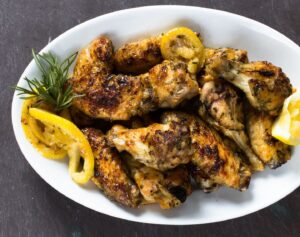
Ingredients
- 2 tablespoons olive oil
- 2 tablespoons butter
- 2 tablespoons finely chopped shallots
- 2 teaspoons dried rosemary
- 1/2 cup lemonade
- 1 teaspoon black pepper
- 1 teaspoon salt
- 10 to 12 chicken wings
Instructions
- Heat oven to 425 degrees F.
- In a small saucepan, heat oil and butter over medium heat.
- Add shallots and rosemary and cook 2 to 3 minutes.
- Add lemonade, pepper and salt. Simmer over low heat for 6 to 8 minutes or until slightly reduced and syrupy.
- Cool slightly.
- Meanwhile, cut chicken wings into three pieces, discarding wing-tip joint. Place wings in shallow pan and coat well with sauce.
- Bake until skin is golden brown, about 30 minutes.
Tinder Experiment Proves How Brutal it is For Average Guys
What’s the most unexpected life lesson you’ve learned recently?
1. Personality is not set in stone. You are able to take control or change it the way you like.
2. Never leave your parents. They are the reason you are here.
3. Never get confused to select between love and friendship. Both have their respective parts to play.
4. When in anger, isolate yourself. Give yourself some time. Finally think about the situation again with a calm mind.
5. People say “Follow your heart”. Not in every situation guys. Instead “Listen to your heart. Act With Your Brain”.
6. Time heals almost everything. Give some time and experience the change.
7. Thoughts control your Feelings. Feelings control your Actions. Actions control your Results. POSITIVE THOUGHTS = POSITIVE RESULTS
Were German soldiers scared of Americans in WW2?
They didn’t like Ma Duece.
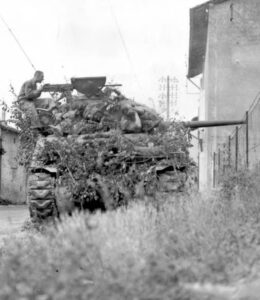
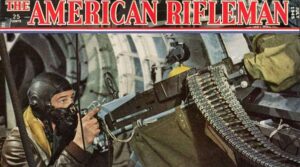
The July 1945 cover of this magazine depicted a waist gunner in a B-17 Flying Fortress and his flexible .50 BMG M2 Browning in an official USAAF photo by Karl Gaston.
By Barrett Tillman
John M. Browning was a historic figure whose guns started the first World War and helped end the second. In 1914, Serbian nationalist Gavrilo Princip used a Browning-designed FN Model 1910 to assassinate Austrian Archduke Franz Ferdinand, inciting the Great War. And though Browning died in 1926, he provided his nation with nearly all its World War II machine guns, its automatic rifle and its foremost sidearm. But he did something even grander. Browning’s magnificent M2 machine gun—chambered in the .50 Browning Machine Gun (BMG) cartridge—gave America and her allies the priceless gift of global air superiority. Nothing else came close.
Actually, the Browning .50 originated in the Great War. American interest in an armor-piercing cartridge was influenced by the marginal French 11 mm design, prompting U.S. Army Ordnance officers to consult Browning. They wanted a heavy projectile at 2700 feet per second (f.p.s.), but the ammunition did not exist. Browning pondered the situation and, according to his son John, replied, “Well, the cartridge sounds pretty good to start. You make up some cartridges and we’ll do some shooting.”
Reputedly influenced by Germany’s 13.2×92 mm SR (.53-cal.) anti-tank rifle, Ordnance contracted with Winchester to design a .50-cal. cartridge. Subsequently, Frankford Arsenal took over from Winchester, producing the historic .50 BMG or 12.7×99 mm cartridge.
The Army then returned to John Browning for the actual gun. Teamed with Colt, he produced prototypes ready for testing and, ironically, completed them by Nov. 11, 1918—the Great War’s end.
The scaled-up version of the .30-cal. (.30-’06 Sprg.) M1917 water-cooled machine gun possessed obvious potential. But the cartridge’s enormous power proved excessive to the Colt-Browning design, forcing the master back to his drafting board. He returned with a buffer system that seemed workable. Tests in 1919 and 1920 confirmed the viability of the cartridge and gun, and Ordnance approved it for production. The result was the M1921 water-cooled .50-cal. machine gun, the basis for today’s M2 model, the fabled “Ma Deuce.”
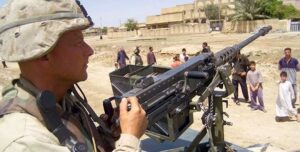
“Ma Deuce” still serves today.
Because of its size and weight, the M1921 was issued as a light anti-aircraft gun, both ground- and ship-based. It remained in Navy use until replaced by 20 mm Oerlikon cannons in 1942.
Meanwhile, a more utilitarian .50-cal. gun was underway. After adopting the M1921, the Army decided to evaluate an air-cooled model, far more tractable for soldiers at 120 lbs. with a tripod. The result was designated “Caliber .50 Machine Gun, Heavy Barrel, M2.” The heavier 36″ barrel was expected to handle heat buildup, but experience led to a 45″ version that was adopted in 1933 and used ever since.
To War
The big Browning fought America’s war from the first day to the last. On Dec. 7, 1941, Navy CPO John Finn responded to the Japanese attack on Kaneohe Naval Air Station, Hawaii, by manning an AN/M2 in an instructional mount (“A/N” stands for Army and Navy). Alone and fully exposed, he fired at the raiders whenever they came within range. “I was out there shooting the Jap planes and just every so often I was a target for some,” he said. “In some cases, I could see their faces.” Though struck by 20 bullets or fragments, he remained at his gun until ordered to report for medical attention. Then he turned to arming his squadron’s remaining planes. His actions resulted in CPO Finn receiving the Medal of Honor.
At least four other .50-cal. gunners received the nation’s highest award, including Lt. Col. William J. O’Brien, an Army battalion commander on Saipan in July 1944. When the Japanese overran his position, he replied with an M1911 in each hand, then dashed to a jeep-mounted M2, according to his citation, “firing into the Jap hordes that were enveloping him” until he was killed.
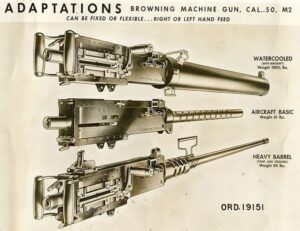
The three main variants of the .50-cal. Brownings were (top to bottom): the water-cooled M1921 (used mostly in the anti-aircraft role); the aircraft-mounted AN/M2, which could be flexible or fixed; and the M2HB used on the ground.
Undoubtedly the best-known M2 engagement occurred on the other side of the world six months later. In France on Jan. 26, 1945, 19-year-old 2nd Lt. Audie Murphy climbed aboard a burning tank destroyer to man the .50 as a company of German infantry advanced. Though hit in one leg, he remained at the gun, shooting down perhaps 50 of the enemy before running dry. Then he returned to his platoon to organize a counterattack. For this, Murphy received the Medal of Honor, and he would become one of the most decorated soldiers in American military history.
With a global need, it seemed that everyone built M2s, from AC Spark Plug Co. to Frigidaire to Guide Lamp. American Rifleman Field Editor Bruce Canfield’s encyclopedic U.S. Infantry Weapons of World War II shows nearly 350,000 M2 Heavy Barrels (M2HB) produced among nearly 2,000,000 .50 calibers of all models during the war years.
Everybody wanted the Ma Deuce in .50 BMG for its fabled power, range and reliability. One wartime study found that stoppages averaged one in 4,000 rounds, as long as headspace was properly adjusted. Armorers determined that a high ratio of malfunctions were due to faulty ammunition or links.
The Ma Deuce’s limit as an anti-aircaft (AA) gun was range, volume of fire and weight of projectile—especially when compared to 20 mm or 5″ cannons. A single-barrel gun firing a 700-gr. bullet could seldom inflict enough damage to destroy a fast attacker. Even multiple guns engaging the same target were marginal. At the Battle of Santa Cruz Islands in October 1942, the fabled carrier U.S.S. Enterprise expended 400 rounds of .50 BMG versus 46,000 rounds of 20 mm; 3,200 rounds of 40 mm; and 400 rounds of 5″. The main reason for the discrepancy probably was engagement range: few attackers closed to within the .50’s effective distance.
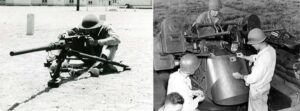
(l.) Adopted in 1933, the M2HB had a 45″ barrel and weighed about 120 lbs. with its tripod. A typical Army infantry battalion had six M2s. In Ordnance Went Up Front Roy Dunlop wrote: “All ground guns could fire single shots … and very accurate fire was possible.” (r.) The M45 quad mount—with four .50-cal. M2s—could be installed in an M16 halftrack or towed as shown in the Pacific Theatre. Although used mostly for anti-aircraft defense, in ground combat the power of four .50-cal. Brownings could be devastating.
Army anti-aircraft units made good use of the M45 quad .50 mount, either towed or mounted on M16 halftracks. Some of the heaviest AA activity occurred during Luftwaffe attacks on Allied airfields on New Year’s Day 1945. In the Metz area, Army AA gunners engaged 25 enemy aircraft, claiming 14 destroyed and four probably downed. Only 11 rounds of 90 mm artillery were fired with a combined 1,270 rounds of 37 and 40 mm, compared to 24,100 rounds of .50 caliber. Quad .50s also were employed in ground combat. A 1945 study noted, “A few bursts from the quadruple .50s directed at any source of small-arms fire very quickly eliminated the trouble.”
Through most of the war, a typical Army infantry battalion operated 20 .30-cal. machine guns (eight M1917 water-cooled) and six .50-cal. M2s. Weapons platoons typically had a jeep-mounted M2 that could be rushed to a trouble spot. The Axis armies had nothing comparable, though Germany issued light machine guns on a greater scale than the Allies. However, short of 20 mm canons, the Germans had no battlefield guns that could penetrate armored cars or personnel carriers at typical engagement distances.

The M2HB (Heavy Barrel) could be employed as a ground arm while mounted on its M3 tripod (l.) or on vehicles, such as with the three MPs in their jeep in the winter of 1944-1945 (r.).
Pre-war match shot and American Rifleman contributing editor Roy F. Dunlap described wartime global trekking in his memoir, Ordnance Went Up Front. He wrote, “I believe the .50s have fewer breakdowns than the .30 caliber guns and that about 75 percent of the repair jobs I did were due to rough handling or carelessness on the part of the gun crew.” For practical application, he said, “I cannot think of a better way to screw up a road junction than to work a .50 to within a couple or three miles, set it in a hollow, camouflaged, and every so often throw a few armor piercers or incendiaries over to the crossing. The blue-tipped incendiaries explode with flash, report and puff of smoke. All ground guns could fire single shots … and very accurate fire was possible.”
In a 1945 summary, the U.S. Army in Europe concluded, “The half-track .50 caliber machine gun—one of the most effective weapons we have—is up where it can be used.” The same report noted that mechanized units had scrounged M2s from downed aircraft and adapted them to coaxial mounts.
On the Pacific isles, typical engagement distances were far closer than in Europe, and Japanese armored vehicles—rarely encountered—were vulnerable to .50-cal. fire. One of the Browning’s main advantages in that environment was its unrivaled penetration, as M2 rounds were far less likely to be deflected by foliage than .30s. Nevertheless, the Marine Corps divisional allotment of Ma Deuces declined from 360 in 1942 to 162 at war’s end.

The .50-cal. water-cooled was the first adopted, and it was the heaviest, too. The guns served in the anti-aircraft role in all theatres of the war. While phased out for shipboard use, the Army continued to use the M2 AA gun.
Air Guns
Entering World War II, the British Royal Air Force installed eight Colt-Browning .303s in Hurricane and Spitfire fighter planes (later augmented with 20 mms) while Germany and Japan favored rifle-caliber guns and 20 mm cannon. But whether Oerlikon or Hispano-Suiza designs, cannon had limited ammunition capacity and were prone to malfunction.
The prewar U.S. Army Air Corps took a middle road. Early Bell P-39Ds had two .50s, four .30s and a 37 mm gun in the nose. The Curtiss P-40B packed two .50s and four .30s, while Lockheed’s futuristic P-38 had four .50s and a 20 mm. The .50-cal. round delivered at least four times the energy of the .30-’06 Sprg. at the same velocity, affording greater penetration and projectile selection. Clearly, the M2 was better suited for destroying modern all-metal aircraft.
Originally the Air Corps adopted the M2 with a 600 r.p.m. cyclic rate. But, as aircraft speeds increased, fighter pilots had less time to track and shoot. Therefore, Frankford Arsenal boosted muzzle velocity from 2700 to 2880 f.p.s. The standard ball cartridge was the 709-gr. projectile atop 253 grs. of IMR-5010. Armorers experimented with various belting combinations, alternating ball, armor-piercing incendiary (API) and tracer. The M2 AP round would defeat nearly an inch of face-hardened steel at 200 yds. Moreover, armor-piercing incendiaries (usually 647 to 662 grs.) were most useful against aircraft, as they could penetrate enemy armor and engine blocks, sever enemy airframe components and ignite enemy fuel tanks.
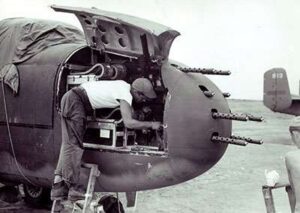
The solid-nose version of the B-25 Mitchell was fitted for eight fixed M2s and could sink enemy ships by .50-cal. gunfire alone.
Tracer rounds, typically about 680 grs., had somewhat different ballistic properties than ball, AP and API, and they did not duplicate the others’ trajectories. Tracers probably were more widely issued to anti-aircraft units than aviation organizations. However, various fighter squadrons adopted different policies. Some loaded the last 50 rounds in each belt entirely with tracers to alert the pilot he was running low. But some very successful pilots shunned tracers. Lieutenant Colonel Francis Gabreski, leading U.S. ace of the European Theater, said, “Sometimes you miss with the first burst and tracers can give you away.”
Browning’s big gun won air superiority for America around the world. Army, Navy and Marine fighters were credited with 25,264 aerial victories, nearly all armed wholly or mainly with AN/M2s. The exceptions were 412 victories gained by British aircraft (mainly Spitfires) in American units and some U.S. night fighters, which were aircraft reconfigured or designed for combat in the dark.
Bombers also packed the M2 as single, manually operated guns and as turret-mounted pairs. The U.S. armed forces consumed vast amounts of ammunition—the St. Louis plant alone delivered 6.7 billion rounds of .30 and .50 caliber during the war. In the fall of 1943, when Eighth Air Force bombers flew unescorted deep penetrations into Reich airspace, one mission might consume more .50-cal. ammunition than a month’s worth of that used by the Fifth Army in Italy.
Around that time, aerial gunners began calling their guns “Mrs. Deuce,” an obvious precursor of today’s familiar “Ma Deuce.” The total Army Air Forces (AAF) overseas expenditure was nearly 460 million rounds, but monthly figures alone were staggering. In April 1945, shortly before Germany surrendered, the Army Air Force in the European and Mediterranean theaters fired nearly 25 million rounds of machine gun and cannon ammunition, the huge majority being .50 caliber. In July, Army airmen flying against the Japanese expended more than 6 million rounds.
During the war, about 100 American fighter pilots downed five or more enemy aircraft in one day to become “instant aces.” Six pilots were credited with seven kills in one mission. They flew very different aircraft—Wildcats, Hellcats, Corsairs, Lightnings and Mustangs—but all had the AN/M2 in common. One instant ace and future NRA member was Marine aviator James E. Swett, who received the Medal of Honor for downing seven (possibly eight) Japanese dive bombers over Guadalcanal in April 1943.
The outright record for aerial victories in a single encounter belonged to the Navy top gun, Cdr. David McCampbell. Flying from U.S.S. Essex over Leyte Gulf in the Philippines on Oct. 24, 1944, he and a wingman tackled a large formation of Japanese fighters. In 90 minutes of combat McCampbell was credited with nine destroyed and two probables while his partner added six more. With the confidence of experience and a disciplined trigger finger, McCampbell made maximum use of his Brownings and ammunition. Given the 2,400-round payload of his Grumman Hellcat, McCampbell averaged just 218 shots per victory.
Perhaps the most cost-efficient aircraft kill of the air war demonstrated the .50’s power. Over Okinawa in May 1945 a Hellcat night fighter stalked a Japanese floatplane harassing U.S. ground troops. Marine Lt. J.E. Smurr closed to minimum range—about 50 ft.—and centered the Aichi seaplane in his illuminated reticle. He pressed the trigger for less than one second and the enemy aircraft disintegrated into a fireball. Armorers found that Smurr had fired only 62 rounds. Throughout the campaign, Marine night hunters averaged 567 rounds per victory regardless of size or type of aircraft.
In a naval war such as the Pacific, .50 calibers inevitably were used against ships. Six M2s could cripple a corvette or a destroyer, whose typical 1/2″ plates offered little protection. Japanese destroyer hulls measured 0.4″ to 0.6″ (10 to 16 mm) whereas .50 ball from a 45″ barrel could penetrate 1/3″ (8 mm) at 500 yds. API rounds penetrated 1″ (25 mm) of homogenous plate at 200 yds. and 3/4″ (18 mm) at 650 yds. Face-hardened plate of 0.9″ (23 mm) was defeated at 200 yds. and 1/2″ at 600. The velocity loss from 36″ aircraft barrels did not seriously reduce the .50’s penetrative qualities, which could puncture engines, boilers and magazines.
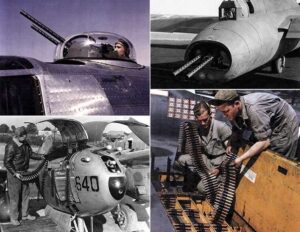
As well as its use on the ground, the big Browning proved a war winner in the air with the Army, Navy and Marines. The U.S. Army Air Force used lighter-weight, .50-cal. AN/M2 Brownings as defensive armament, including as a pair in a turret on a B-17 Flying fortress (top l.) as well as in the tail of a B-17 (top, r.). They were also used on fighter aircraft, such as in the nose of the P-38 Lightning (below l.) and in the wings of fighter aircraft in Europe such as the P-47 Thunderbolt (below, r.).
Certainly the outer limits were achieved by North American B-25H bombers optimized for shipping attacks. With eight nose- and fuselage-mounted .50s plus a top turret, two waist guns and the twin-gun tail position, the H model Mitchell was literally a flying gunship that could immobilize merchantmen—even without the short-barreled 75 mm cannon. However, when the H model entered combat in the China-Burma-India Theater in early 1944, shipping targets were rare. River traffic, on the other hand, was easily destroyed by fighters and gunships.
A study of Navy patrol bombers concluded that during 1945, “Dozens of small vessels were destroyed by fires caused by incendiary hits or strafing alone.” Consolidated PB4Y-2 Privateer bombers expended 2 million rounds of .50 caliber on 600 or more surface vessels, contributing to sinking as many as 300. “The effect was to cripple the remaining Japanese sea transport in most areas and to cause withdrawal of many vessels not sunk because of the danger of attack … .”
The AN/M2 was fully appreciated by the war’s midpoint. In 1943, Gen. Henry “Hap” Arnold, chief of the Army Air Forces, declared the Browning “the outstanding aircraft gun of the Second World War.” He added, “This weapon … is the backbone of offensive and defensive gun [sic] for American aircraft and was brought to such a state of perfection by the Ordnance Department during the years of peace prior to the present conflict that it has enabled the Army Air Forces, the U.S. Navy and Marine Corps to show a definite superiority in aircraft gun power through this global war.”
Despite the M2’s immense success, some operators wanted more. The M3 .50 caliber boosted cyclic rate to 1,200 r.p.m., but the increase came at too high a price. Tests showed greater barrel erosion, and rounds tended to “keyhole.” Only 2,400 M3s were delivered before V-J Day, but development continued. Subsequently, the M3 armed the first generation of American jet fighters, pointing the way to victory in MiG Alley during the Korean War.
In typical military fashion, in 2004 the Army tried to replace the M2 with a less effective arm at twice the price. The wasteful three-year program to develop the XM312 flopped during tests in 2005 but lingered two more years before cancellation. At that point “Big Army” defaulted to the best option: buying more M2s.
Longevity remains a hallmark of John M. Browning’s designs. His timeless M1911 pistol is more widely used today than ever, and “Ma Deuce,” dating from 1921, shows no signs of retiring. In fact, in 2015 the 324th M2 ever produced was finally removed from service—after 94 years in the inventory. The old warhorse was being retired because current standards would require extensive modification. Army Materiel Command quoted an armorer at Anniston Army Depot who said, “Looking at the receiver, for its age, it looks good as new and it gauges better than most of the other weapons.” Said John Clark, a small arms repair leader, “I’d rather put this one on display than send it to the scrap heap.” A veteran approaching its centennial, the M2 certainly deserves an honorable retirement—though its relatives will remain on the firing line well into the current century.
In this article
, WWII, .50 BMG M2 BROWNING, JOHN M. BROWNING, MA DEUCE, BARRETT TILLMAN
HOT Girl Finds out what it’s like to be an Average Guy on Tinder
Have you ever had such a close call it makes your skin shiver everytime you think about it? If so, what happened?
I first thought it was the worst case of heartburn ever. After working two hours I decided to drive home and have my husband take me to the hospital’s ED. After frantically examining me, several blood draws, multiple EKG tests, and waiting for a few hours I was told it was not my heart, but my liver. An hour later a cardiologist stopped by and told me I had indeed suffered a mild heart attack, and luckily my heart suffered no damage. I would be transported to the main hospital that night for an early morning catheterization to see what was going on.
After the catheterization, the surgeon came to my room to discuss the procedure with my husband and me. He asked how I was doing, and I told him, “That is what I am paying you to tell me.” Looking very somber he told me, “Well you are lucky to be here right now. When we went in, we found your Widow Maker was 99% blocked. From the time of your first chest pain until we inserted the stent was much too long. Your chance of surviving was about 3%, I have never had a patient live through a blockage like that for longer than thirty minutes. In addition, you should have severe heart damage, and you have none. I can’t explain why you are here, and your heart is not damaged. Somebody must want you alive.”
All I could say is, “Damn! Does this mean I can still perform with the New York City Ballet troupe as lead in “Swan Lake?” He chuckled, “As long as you were already part of the troupe before your heart attack!”
I do not like to think about that day, the news, or how close I came to shaking hands with Jesus, or whoever is waiting on the other side. Instead, I joke and say I was knocking at death’s door, and thank god no one answered!
What are some unwritten social rules everyone should know?
- Never give advice until you’re asked.
- Do not make plan infront of those friends you are not involving.
- Don’t talk to someone if they have headphones in.
- If someone is being quiet and doesn’t look like in a mood to talk, don’t nag them by asking ‘what’s wrong?’ every freaking second. Give them some space and ask once or twice max. If they want to, they’ll come up and share it with you.
- Don’t close talk/invade someone’s personal space.
- Do not use your cell phone at movies etc.. it breaks the “spell” and distracts from other’s enjoyment of the performance.
- If invited to a dinner party and expected to arrive at 7 P.M., arrive no later than 15 minutes after the hour.
- If someone pays for your meal, invite them over/take them out for a meal sometime. Even if they decline, it’s the invitation that matters.
- Don’t talk whilst chewing..
- The right side of the escalator is for standing, the left side is for walking.
- If a person is speaking directly to you, staring at your phone is rude as shit.
- Don’t date your friends exes.
- Always let people out before you enter.
-
Be quiet when other people are asleep. That means more than not talking — not slamming doors, drawers, etc.
-
Put things back where you found them.
What is the single most mind-blowing fact that you did not believe until you looked it up?
The photo is not an original shot of an execution.
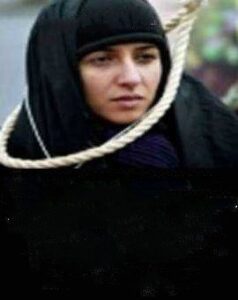
In Iran, it is against the law to put to death female prisoners who are virgin. So, the Basij militias of the government marry and rape virgin female prisoners to get them ready to be killed.
In Iran, the law says that women who are still virgins cannot be put to death. So, the government sets up marriages the night before executions and forces female prisoners to have sexual relations with Besic members. “Women whose new husbands have raped them” are then allowed to be put to death. The Besic member told the reporter, “Even though it’s legal, I’m sorry for what I did.” During his speech, he said that he had just been let out of jail for letting two young people go who had been arrested during the street protests in Iran after the election. Members of Besic say that some of the prisoners who fight back are controlled with sleepy pills and that “many of the prisoners who fight back would rather be raped than killed. “The Besic member tells the reporter what happened by saying, “After the rape was over, I could hear them screaming and calling for help.” I’ll never forget how one of the girls used her nails to scratch her face and neck. She had deep cuts all over.
American Reacts to 6 LIES America Told Me about Europe || Life in the UK
Is Taiwan very important to China? China wants Taiwan so much.
From the point of view of the Chinese government, Taiwan is important for historical reasons, as unification with the rest of China would represent a clear end to China’s century of humiliation and the end of any pro-western colonial presence on Chinese territory. Any Chinese leader who brought Taiwan back into a unified China would be remembered in the history books as the leader who brought this period of humiliation to an end, and would be remembered for this single accomplishment.
Most PRC Chinese also feel this way about Taiwan.
In short, it would be the single largest accomplishment in Chinese history in the 21st century.
Most Americans, including US government officials, do not understand the depth of the Chinese commitment to unification with Taiwan.
If they can understand the commitment of Zionist Jews to Israel and a homeland in the Middle East, why can’t they understand China’s commitment to unification with Taiwan?
Things Genghis Khan did to His Slaves
Why can you only have one child in China?
This is not true.
There are no limits on how many children that you can have in China. So please, stop flooding my inbox with questions about “invasions of Taiwan”, “one child birth policy”, and “when China will collapse”. These are simply CIA propagandized narratives that the gullible believe.
But, instead I do want to address something that I personally find very interesting. Take note people! China does not play around. They are SERIOUS in regards to their population and raising children. It’s not an after-thought like it is in the United States.
Considerations, on the citizenship of the baby.
First off, take note, If you give birth in China, the child is stateless.
It does not get automatic citizenship as in the West. Oh, you can give birth, but it will not be a legal citizen, and will not be protected by law. It will be a burden of the couple that produced the baby.
If you want the child to become a Chinese citizen, then be advised;
You can give birth to a hundred children if you want (and are able to), but…
- One parent must be Chinese and have a Houkou (a family register),
- BOTH parents must pass paternity tests,
- The child must not have any mental, emotional or physical deformities. (this is tested while in the womb by DNA testing, and the burden of payment is on the parents.)
- Both parents must be able to afford the child. Not be a burden on society.
If the child, or parents fail any of the above considerations, then the baby will remain stateless and will need to exit the nation with the parents if they want to provide some other national citizenship for it.
That is the REAL deal.
…
One of the tools of manipulation of the people of the West is to keep them ignorant. Then fabricate fantasies that seem to make sense to the ignorant, the illiterate, and the moronic. One such lie is the idea and concept of “one child birth policy”.
If you believe it, you should be ashamed of yourself.
How did the policy of appeasement lead to World War 2?
When I was a child, my father told me to always stand my ground against bullies, “Because when you give them one thing, they will take the whole hand!” And this is true. This is what appeasement is all about. Its a misguided belief we all know, since childhood, doesn’t work. You don’t want trouble. You want to avoid a fight. So you give the bully whatever he desires.
The British establishment at the time, as did many other European leaders, felt that it was best to “play nice” with Hitler and his Nazi party. Just give him what he wants. He wants to add some more countries, annex some more lands for Germany? Let him. Let him make his Fatherland Great Again. Who cares. It sure beats war, doesn’t it? And it does… until the moment it doesn’t. The same line of thinking is seen today with those who hate NATO and sympathize with Russia. They want to give up on aid to Ukraine. Because they don’t want to anger the bully that started the war. This is appeasement, plain and simple.
It didn’t work in WWII. And it sure as hell won’t, now. Appeasement and playing nice with dictators leaves a dictator to feel secure, in control. It makes him feel strong, and makes you look weak. And it only emboldens him, and his friends, to take military action. “Peace in our time” only means: “A wider war is now certain… only a little bit later.”
Which movie(s) made you cry?
Yes! The following scenes from the movie The Pursuit of Happyness made me cry:
- Chris and his son sleeping in a bathroom:

With no money, no job and homeless, Chris turns a dirty subway restroom into an imaginary cave for his son and gets him to sleep there. Being at the depth of his poverty and despair, Chris breaks down in this scene and is shown blocking the door so that his son can sleep well. Heart touching scene.
2. The five-bucks scene:

Chris’s boss forgets his wallet upstairs and is in a hurry to attend a meeting. He asks Chris to lend him five bucks. Being at the rock bottom of poverty, five bucks mattered for Chris and he lends his boss too. This scene regains our faith in humanity and the act of giving to those in need.
3. Chris gets the job:

Who can forget this scene where he gets the job and is asked about his struggle? This scene still makes me emotional.
Will Smith is a genius!
Is there anything that China can teach the west about happiness?
I have lived in China for a few years, and I think the west would be a happier place if we adopted the following Chinese wisdoms:
- if you cause someone embarrassment, you should also be ashamed of yourself – so, better don’t do that to anyone. It would be such a nice change from our silly, childish revenge culture.
- take an entire hour for lunch every day. Better even: two. It celebrates the day, and makes for a more relaxed life.
- get seriously into savings and whatever else you can do to build your fortune. We westerners have a debt culture. We live in denial of how unhappy that makes us.
- choose the middle ground for all things. We westerners always look for extremes. But longterm happiness is not found in thrill, only in balance.
- take naps during the day. You would be amazed how much happier you will be.
- spend more time with your folks. Western society is always trying to isolate the individual, when life is so much nicer shared with others – especially your family.



